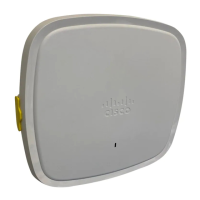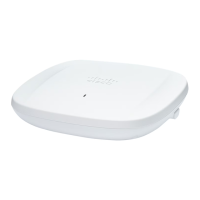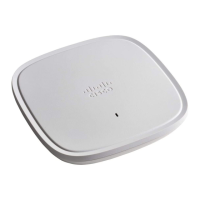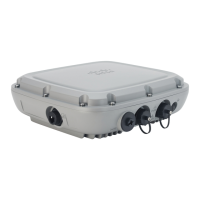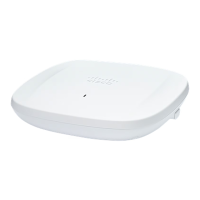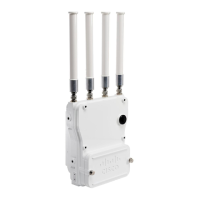The Bluetooth Low Energy (BLE), Zigbee, Thread, and other multiprotocol 802.15.4 devices use the Omni
IoT radio.
Note
• Integrated internal antennas that are omni directional in azimuth for 2.4-GHz, 5-GHz, and 6-GHz bands.
• Scanning radio utilizes two 2.4-GHz, 5-GHz, and 6-GHz antennas.
• Multiuser Multiple-Input Multiple-Output (MU-MIMO) technology for uplink and downlink.
• Orthogonal Frequency Division Multiple Access-based (OFDMA-based) scheduling for both uplink and
downlink.
• Multigigabit Ethernet (mGig)
• The following hardware external interfaces:
• 2x100/1000/2500/5000 Multigigabit Ethernet (RJ-45)
• RS-232 Console Interface through RJ-45
• Recovery push button (enables partial or full system configuration recovery)
• USB 2.0 port
• One multicolor LED
• Integrated Bluetooth Low Energy (BLE) radio to enable IoT use cases such as location tracking and
wayfinding.
• Intelligent Capture probes the network, and provides Cisco DNA Center with deep analysis.
• Spatial Reuse (also known as Basic Service Set [BSS] coloring) that allows APs and their clients to
differentiate between multiple BSS, thus permitting more simultaneous transmissions.
• Power savings mode called Target Wake Time (TWT), which allows a client to stay asleep and wake up
only at prescheduled (target) times to exchange data with the AP. This provides significant energy savings
for battery-operated devices.
• Cisco Digital Network Architecture (DNA) support to enable Cisco DNA Spaces, Apple FastLane, and
Cisco Identity Services Engine.
• Optimized AP Roaming for ensuring that client devices associate with the AP in the coverage range that
offers the fastest data rate available.
• Cisco CleanAir technology enhanced with 160-MHz channel support. CleanAir delivers proactive,
high-speed spectrum intelligence across 20, 40, 80, and 160-MHz-wide channels to combat performance
problems arising from wireless interference.
The AP supports lightweight deployments (using Cisco Wireless Controllers). The AP also supports the
following operating modes:
• Local mode: This is the default mode for the AP. In this mode, the AP serves clients.In local mode, the
AP creates two CAPWAP tunnels to the Cisco controller, one for management and the other for data
traffic. This is known as central switching because the data traffic is switched (bridged) from the AP to
the controller where it is then routed.
Cisco Catalyst 9136I Series Access Point Hardware Installation Guide
2
About Cisco Catalyst 9136I Series Access Points
Cisco Catalyst 9136I Series Access Points Features

